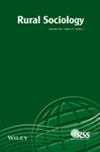Early Family Formation, Selective Migration, and Childhood Conditions in Rural America☆
IF 1.9
3区 社会学
Q2 SOCIOLOGY
引用次数: 0
Abstract
Thirty years ago, rural Americans got married and had children at significantly younger ages than urban Americans. More recent data indicate that these differences persist today, but our understanding of what drives these differences remains limited. To address this gap, we (1) generate Kaplan–Meier estimates of the ages of the first marriage, first union, and first birth among those who lived in rural and urban areas in 2019, (2) evaluate the extent to which rural–urban differences in the timing of family formation reflect selective migration, (3) assess whether rural–urban differences in childhood SES and demographic characteristics further explain differences in timing, and (4) explore rural–urban differences by gender. We find substantial 4.3, 3.8, and 5.1‐year gaps in the ages at which rural and urban women marry, start unions, and become parents, respectively. These gaps largely do not reflect selective migration. Differences in women's age of first birth are attributable to differences in childhood conditions, yet differences in marital and union timing remain unexplained. Rural–urban gaps in the timing of family formation are much larger among women than among men. These patterns of early family formation in rural America have critical implications for families' and children's well‐being as well as rural depopulation.美国农村地区的早期家庭组建、选择性移民和童年生活状况☆。
30 年前,美国农村居民的结婚和生育年龄明显小于城市居民。最近的数据表明,这些差异在今天依然存在,但我们对造成这些差异的原因的了解仍然有限。为了弥补这一差距,我们(1)对 2019 年生活在农村和城市地区的人的首次结婚、首次结合和首次生育的年龄进行了卡普兰-梅耶估计,(2)评估了城乡在组建家庭时间上的差异在多大程度上反映了选择性迁移,(3)评估了城乡在童年社会经济地位和人口特征上的差异是否进一步解释了时间上的差异,以及(4)探讨了城乡在性别上的差异。我们发现,农村妇女和城市妇女在结婚、开始同居和成为父母的年龄上分别存在 4.3 岁、3.8 岁和 5.1 岁的巨大差距。这些差距在很大程度上并不反映选择性迁移。妇女初次生育年龄的差异可归因于童年条件的差异,但结婚和结合时间的差异仍无法解释。城乡之间在组建家庭时间上的差距,女性要比男性大得多。美国农村早期组建家庭的这些模式对家庭和儿童的福祉以及农村人口减少具有重要影响。
本文章由计算机程序翻译,如有差异,请以英文原文为准。
求助全文
约1分钟内获得全文
求助全文
来源期刊

RURAL SOCIOLOGY
SOCIOLOGY-
CiteScore
4.60
自引率
13.00%
发文量
47
期刊介绍:
A forum for cutting-edge research, Rural Sociology explores sociological and interdisciplinary approaches to emerging social issues and new approaches to recurring social issues affecting rural people and places. The journal is particularly interested in advancing sociological theory and welcomes the use of a wide range of social science methodologies. Manuscripts that use a sociological perspective to address the effects of local and global systems on rural people and places, rural community revitalization, rural demographic changes, rural poverty, natural resource allocations, the environment, food and agricultural systems, and related topics from all regions of the world are welcome. Rural Sociology also accepts papers that significantly advance the measurement of key sociological concepts or provide well-documented critical analysis of one or more theories as these measures and analyses are related to rural sociology.
 求助内容:
求助内容: 应助结果提醒方式:
应助结果提醒方式:


